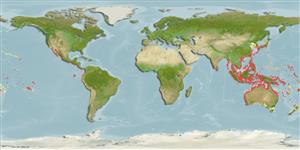Environment: milieu / climate zone / depth range / distribution range
Ecologia
marino associati a barriera corallina; distribuzione batimetrica 25 - 30 m (Ref. 93839). Tropical
Western Pacific: Tokyo Bay to Taiwan and southward along the western Pacific. Reported from Samoa (Ref. 592).
Size / Peso / Age
Maturity: Lm ? range ? - ? cm
Max length : 14.0 cm TL maschio/sesso non determinato; (Ref. 48635)
Short description
Chiavi di identificazione | Morfologia | Morfometria
Spine dorsali (totale) : 8; Raggi dorsali molli (totale) : 9; Spine anali: 2; Raggi anali molli: 8. Distinguished by having the following characteristics: dorsal fin rays VII-I, 9; anal fin rays II, 8; pectoral fin rays 14; pelvic-fin rays I, 5; pored lateral line scales 24; total gill rakers 17, developed gill rakers 12 (Ref. 93839). Further characterized by whitish body color; 6 red-brown stripes, incomplete stripes or rows of spots in between; base of caudal fin with large black spot; greatest depth of body 2.5-3.0 in SL (Ref. 90102).
Occurs along cliffs and slightly deep water (Ref. 559, 48635), in coral reef crevices (Ref. 9710). Nocturnal species (Ref. 7300). Forms small and large aggregations (Ref 90102).
Life cycle and mating behavior
Maturities | Riproduzione | Spawnings | Egg(s) | Fecundities | Larve
Mouthbrooders (Ref. 240). Distinct pairing during courtship and spawning (Ref. 205).
Masuda, H., K. Amaoka, C. Araga, T. Uyeno and T. Yoshino, 1984. The fishes of the Japanese Archipelago. Vol. 1. Tokai University Press, Tokyo, Japan. 437 p. (text). (Ref. 559)
IUCN Red List Status (Ref. 130435)
Threat to humans
Harmless
Human uses
Strumenti
Special reports
Download XML
Fonti Internet
Estimates based on models
Preferred temperature (Ref.
123201): 21.1 - 28.6, mean 27.8 °C (based on 92 cells).
Phylogenetic diversity index (Ref.
82804): PD
50 = 0.5000 [Uniqueness, from 0.5 = low to 2.0 = high].
Bayesian length-weight: a=0.00501 (0.00201 - 0.01253), b=3.26 (3.04 - 3.48), in cm total length, based on LWR estimates for this (Sub)family-body shape (Ref.
93245).
Trophic level (Ref.
69278): 3.5 ±0.50 se; based on food items.
Resilienza (Ref.
120179): Alto, tempo minimo di raddoppiamento della popolazione meno di 15 mesi (Preliminary K or Fecundity.).
Fishing Vulnerability (Ref.
59153): Low vulnerability (10 of 100).
Nutrients (Ref.
124155): Calcium = 128 [69, 204] mg/100g; Iron = 0.819 [0.495, 1.340] mg/100g; Protein = 18.6 [17.5, 19.6] %; Omega3 = 0.101 [0.060, 0.175] g/100g; Selenium = 31.5 [15.7, 63.8] μg/100g; VitaminA = 85.2 [29.6, 241.9] μg/100g; Zinc = 1.76 [1.18, 2.52] mg/100g (wet weight);
